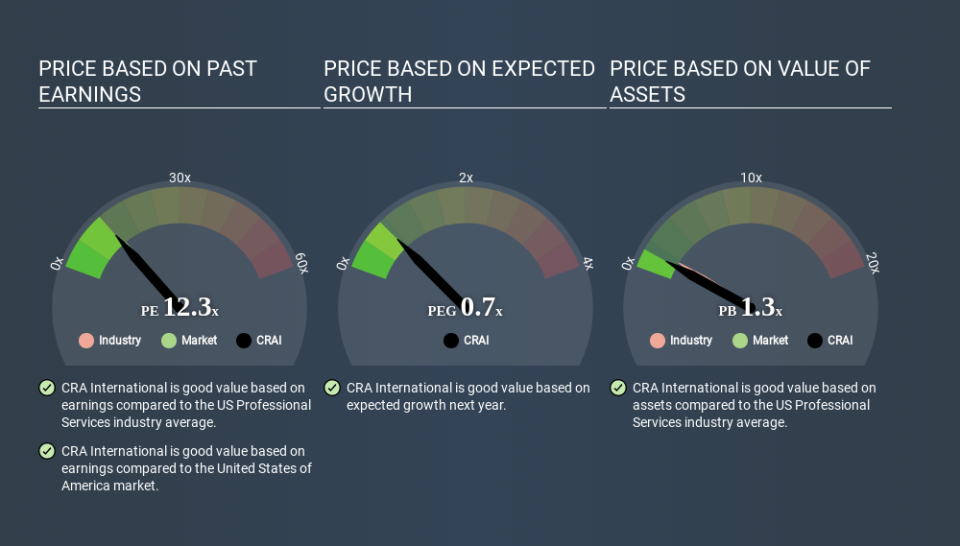What Is CRA International's (NASDAQ:CRAI) P/E Ratio After Its Share Price Tanked?

Unfortunately for some shareholders, the CRA International (NASDAQ:CRAI) share price has dived 30% in the last thirty days. Indeed the recent decline has arguably caused some bitterness for shareholders who have held through the 36% drop over twelve months.
Assuming nothing else has changed, a lower share price makes a stock more attractive to potential buyers. In the long term, share prices tend to follow earnings per share, but in the short term prices bounce around in response to short term factors (which are not always obvious). So, on certain occasions, long term focussed investors try to take advantage of pessimistic expectations to buy shares at a better price. One way to gauge market expectations of a stock is to look at its Price to Earnings Ratio (PE Ratio). Investors have optimistic expectations of companies with higher P/E ratios, compared to companies with lower P/E ratios.
Check out our latest analysis for CRA International
Does CRA International Have A Relatively High Or Low P/E For Its Industry?
CRA International's P/E is 12.33. As you can see below CRA International has a P/E ratio that is fairly close for the average for the professional services industry, which is 12.4.
CRA International's P/E tells us that market participants think its prospects are roughly in line with its industry. So if CRA International actually outperforms its peers going forward, that should be a positive for the share price. I would further inform my view by checking insider buying and selling., among other things.
How Growth Rates Impact P/E Ratios
P/E ratios primarily reflect market expectations around earnings growth rates. That's because companies that grow earnings per share quickly will rapidly increase the 'E' in the equation. That means even if the current P/E is high, it will reduce over time if the share price stays flat. And as that P/E ratio drops, the company will look cheap, unless its share price increases.
CRA International's earnings per share fell by 4.3% in the last twelve months. But EPS is up 13% over the last 5 years.
Remember: P/E Ratios Don't Consider The Balance Sheet
Don't forget that the P/E ratio considers market capitalization. So it won't reflect the advantage of cash, or disadvantage of debt. Hypothetically, a company could reduce its future P/E ratio by spending its cash (or taking on debt) to achieve higher earnings.
Spending on growth might be good or bad a few years later, but the point is that the P/E ratio does not account for the option (or lack thereof).
So What Does CRA International's Balance Sheet Tell Us?
Since CRA International holds net cash of US$26m, it can spend on growth, justifying a higher P/E ratio than otherwise.
The Bottom Line On CRA International's P/E Ratio
CRA International has a P/E of 12.3. That's around the same as the average in the US market, which is 12.9. Although the recent drop in earnings per share would keep the market cautious, the relatively strong balance sheet will allow the company to weather a storm; so it isn't very surprising to see that it has a P/E ratio close to the market average. Given CRA International's P/E ratio has declined from 17.7 to 12.3 in the last month, we know for sure that the market is significantly less confident about the business today, than it was back then. For those who don't like to trade against momentum, that could be a warning sign, but a contrarian investor might want to take a closer look.
When the market is wrong about a stock, it gives savvy investors an opportunity. If it is underestimating a company, investors can make money by buying and holding the shares until the market corrects itself. So this free visual report on analyst forecasts could hold the key to an excellent investment decision.
You might be able to find a better buy than CRA International. If you want a selection of possible winners, check out this free list of interesting companies that trade on a P/E below 20 (but have proven they can grow earnings).
If you spot an error that warrants correction, please contact the editor at editorial-team@simplywallst.com. This article by Simply Wall St is general in nature. It does not constitute a recommendation to buy or sell any stock, and does not take account of your objectives, or your financial situation. Simply Wall St has no position in the stocks mentioned.
We aim to bring you long-term focused research analysis driven by fundamental data. Note that our analysis may not factor in the latest price-sensitive company announcements or qualitative material. Thank you for reading.

